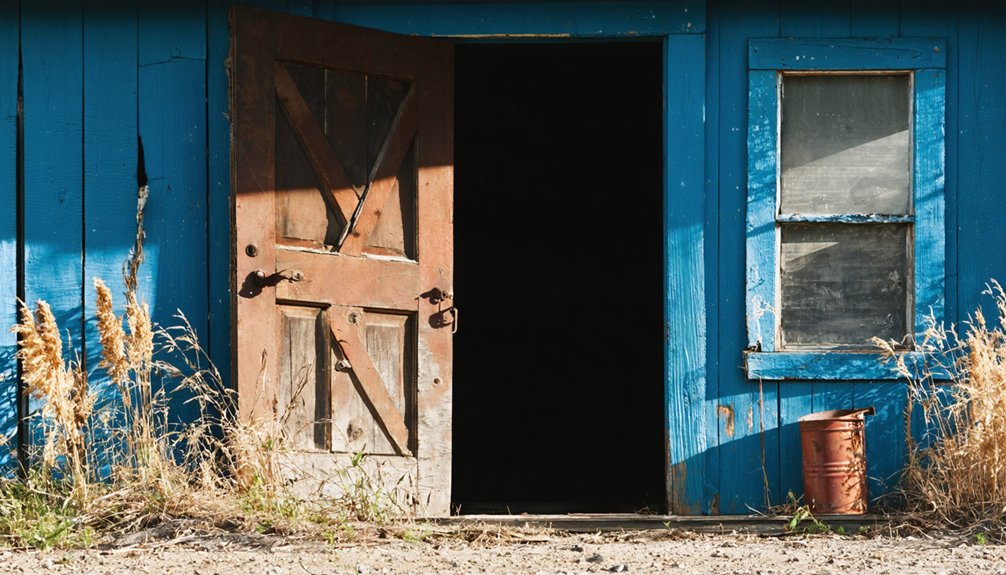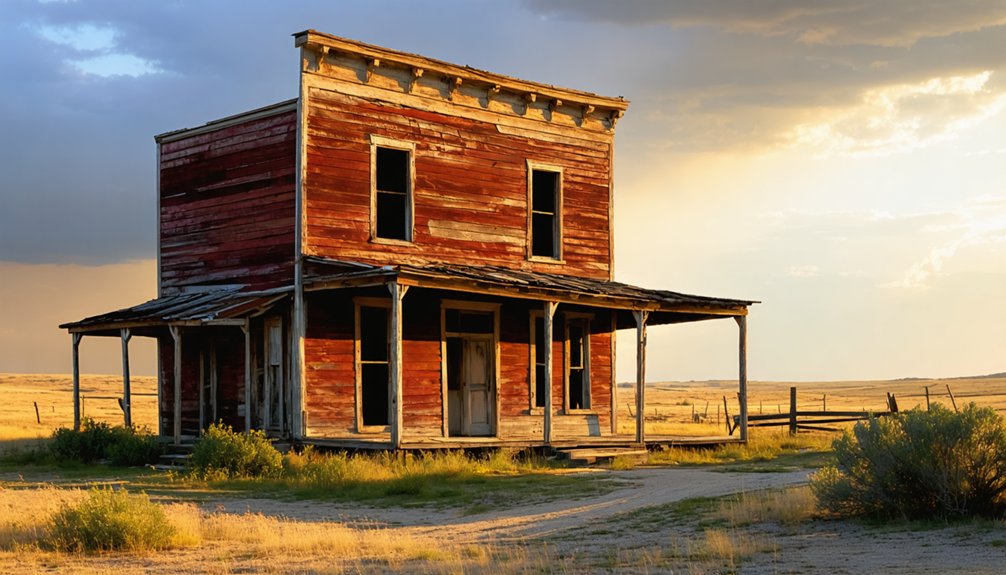You’ll discover Beaver City’s remnants among South Dakota’s historic ghost towns, where it emerged during the Great Dakota Boom of 1890. The town flourished after the Chicago Northwestern Railway established a stop in 1906, creating a bustling hub of miners and merchants. Local quartzite and timber buildings once lined the streets, while sod houses dotted the residential areas. Today, weathered ruins tell tales of this railroad settlement’s rise and fall across the Dakota prairie.
Key Takeaways
- Beaver City emerged in 1890 during South Dakota’s Great Dakota Boom as a railroad settlement and mining hub.
- The town featured sod buildings, locally sourced stone structures, and a grid layout designed for its mining population.
- Economic prosperity centered around the Chicago Northwestern Railway depot and mining activities during the late 1800s.
- Decline began in the early 1900s due to falling cattle prices, volatile mining markets, and railroad service termination.
- Today, Beaver City exists as a ghost town with deteriorating structures scattered across South Dakota’s landscape.
The Birth of a Railroad Settlement (1890)
In the midst of South Dakota’s Great Dakota Boom, Beaver City emerged in 1890 as one of hundreds of railroad settlements that transformed the territory’s landscape.
You’d have witnessed the familiar pattern: railroad crews laying track, followed swiftly by the appearance of a depot, grain elevators, and warehouses along the rail siding.
Like 228 other towns platted during this era, Beaver City’s location was strategically chosen for railroad connectivity.
You would’ve seen the settlement spring to life within weeks of the rail’s arrival – new buildings rising, merchants setting up shop, and farmers bringing their grain to market.
The depot quickly became the heart of the community, handling everything from mail and telegrams to freight shipments, establishing essential links between Beaver City and the wider commercial world.
Life in Early Beaver City
Life in early Beaver City centered around the sixteen original ten-acre lots where settlers built their first homes and established their community.
You’d have found a mix of wood-frame houses and dugouts dotting the landscape, with fences marking property boundaries and protecting livestock. As part of this pioneer community, you’d have worked alongside your neighbors, sharing tools and labor while cultivating the rich black loam soil.
The nearby river provided essential irrigation through a network of ditches you’d have helped dig and maintain. Your days would’ve revolved around agriculture practices, tending to crops and livestock, while social life centered on the wooden schoolhouse and religious gatherings. The early settlers often traded at general stores that served as economic hubs for rural farming communities.
Swedish settlers brought their customs, creating a tight-knit community bound by shared cultural traditions and mutual support. When the Black Hawk War drove residents from nearby Circleville in 1886, many found refuge and a new home in the growing settlement.
Economic Peak and Daily Operations
During the Dakota Boom of the 1870s and 1880s, Beaver City flourished as a bustling mining hub where you’d have found prospectors working claims alongside well-funded mining operations.
The arrival of the Burlington Northern railroad transformed the town’s fortunes, making mining profits soar by reducing transportation costs for ore shipments and essential supplies.
The railroad’s arrival slashed shipping costs and boosted mining profits, turning a remote outpost into a thriving economic hub.
You would’ve seen a vibrant Main Street lined with general stores, blacksmiths, and saloons serving as community hubs for miners and railroad workers.
The town’s economic pulse beat in sync with its mines, as local businesses rose and fell with each new mineral discovery.
While some struck it rich, others faced the harsh realities of mining’s boom-and-bust nature.
Success required both technical know-how and substantial capital, making it a high-stakes venture in this Black Hills boomtown. Like many settlements near the Black Hills, the area held special significance to Native American tribes who had inhabited the region for thousands of years.
Architecture and Town Planning
Looking at Beaver City’s layout, you’ll notice it differed from typical railroad town designs of the era, with its organically developed paths and clustered buildings serving the mining community’s immediate needs.
The town, originally named after the Lakota word for beaver, used locally sourced materials, primarily timber from surrounding forests and basic stone foundations, creating utilitarian structures that prioritized function over form. Similar to the remains of mining camps throughout the Black Hills, Beaver City showcases the practical building approaches common during the region’s resource extraction boom.
Today, you’d find few traces of the original architecture, as time and abandonment have reduced most buildings to scattered ruins and weathered foundations.
Railroad Town Design
As railroad companies expanded across South Dakota in the late 1800s, they established precisely planned settlements like Beaver City using standardized town layouts that maximized efficiency and profit.
You’d have found the town’s railroad infrastructure centered around a depot that served as both passenger terminal and freight station, positioned strategically along the tracks.
The town layout followed the typical grid pattern you’d expect from a railroad town, with the main street running parallel to the tracks. Land offices were essential buildings in these railroad towns, helping settlers acquire property in former Indian territories.
Every seven to ten miles along the line, these planned communities emerged with designated areas for freight yards, warehouses, and commercial districts.
Local businesses, including lumber yards and general stores, clustered near the depot where they could easily receive shipments and serve the growing community.
The Western Town Lot Company platted Capa in 1904, demonstrating the railroad’s significant role in establishing new settlements.
Prairie Building Materials
The stark reality of prairie living shaped the architectural choices in Beaver City, where settlers turned to readily available materials like sod and native stone to construct their homes and businesses.
You’ll find that sod construction dominated the landscape, with settlers cutting thick strips of prairie grass and soil to form sturdy blocks, stacking them like bricks to create walls two blocks thick. The scarcity of trees in the region required settlers to be resourceful with building materials. The Homestead Act of 1862 brought European immigrants who introduced these traditional building techniques.
When you examine the remaining foundations, you’ll notice how the settlers adapted to scarce resources. They’d reinforce their structures with wooden corner posts when lumber became available through the railroad.
Local stone, particularly Sioux quartzite, gave commercial buildings their distinctive character. These natural materials provided remarkable insulation – keeping inhabitants warm during harsh winters and cool through scorching summers.
Lost Architectural Heritage
Beyond the practical use of prairie materials, Beaver City’s architectural legacy reveals a thoughtfully planned frontier settlement from 1878.
You’ll find the town’s architectural significance in its careful layout, with commercial buildings clustered in the center and residential areas spreading outward. This cultural memory of frontier town planning shows how settlers balanced their need for community with practical considerations like access to resources and transportation routes. The town’s growth accelerated after the Chicago Northwestern Railway established a key stop there in 1906.
- You can trace the original street grid designed for a growing mining population
- Each building placement reflects frontier-era social and economic priorities
- The town’s layout mirrors the era’s approach to creating instant communities
- Commercial and residential zones show clear separation of public and private life
- Infrastructure placement reveals how natural features shaped frontier settlements
The Path to Abandonment
You’ll find Beaver City’s decline mirrors many former railroad towns that lost their economic foundations when rail service dwindled and eventually ceased.
The town’s prosperity had hinged on its position as a transportation hub, but as railroads rerouted and motor vehicles gained dominance, businesses shuttered and residents sought opportunities elsewhere.
What began as a gradual exodus in the early twentieth century accelerated when major employers closed, leaving behind vacant buildings and diminished prospects for those who remained.
Economic Forces Drive Exodus
While Beaver City once thrived as a hub of ranching and agriculture, mounting economic pressures from the mid-20th century onward triggered an unstoppable exodus that would ultimately seal its fate.
You’ll find the story of economic migration written in the abandoned storefronts and empty homesteads, where falling cattle prices and volatile commodity markets drove family ranches to bankruptcy. The agricultural decline hit particularly hard as processing facilities closed, forcing ranchers to truck livestock hundreds of miles to reach distant markets.
- Mechanization and large-scale agribusiness pushed out small family operations
- Limited access to essential services like healthcare hastened population loss
- Young families couldn’t afford escalating housing costs
- Local businesses shuttered as customer bases dwindled
- Deteriorating infrastructure isolated the community from crucial commerce routes
Railroad Service Ends Era
The final nail in Beaver City’s coffin came with the termination of railroad service in the mid-20th century.
You’d have found the once-bustling depot, heart of the town’s social and economic life, standing empty as rail traffic dwindled in the post-war years. The rise of automobiles and trucking spelled doom for many small-town rail lines, including the essential connection serving Beaver City.
As railroad nostalgia replaced reality, you would’ve witnessed the town’s lifeblood draining away.
Without rail service, farmers couldn’t ship their grain, merchants couldn’t stock their shelves, and mail delivery slowed to a crawl. Community isolation set in quickly – no more telegraph office, no more gathering at the depot platform to swap news and greet visitors.
The town’s destiny, like so many others, was sealed when those steel rails went silent.
What Remains Today

Modern visitors to Beaver City will find a haunting collection of deteriorating structures scattered across South Dakota’s southwestern landscape. The current conditions reveal a ghost town in its truest form – roofless buildings stand like silent sentinels while foundations peek through prairie grass.
Historical remnants include an abandoned motel and church, their weathered walls telling stories of a once-thriving community.
Time-ravaged walls of the old motel and church whisper tales of bustling streets and neighborhood life long past.
- Wind-worn buildings stand as evidence of frontier determination
- Hand-painted signs offer glimpses into the town’s rich past
- Former businesses and homes slowly return to the prairie
- Natural elements gradually reclaim the historical site
- Deteriorating structures create an authentic ghost town atmosphere
You’re free to explore the site, but watch your step – unstable floors and crumbling stairs make navigation treacherous through these fascinating ruins of the American West.
Frequently Asked Questions
Were There Any Notable Crimes or Lawless Incidents in Beaver City’s History?
You won’t find significant crime statistics or notable law enforcement records from this settlement. Historical documents and regional accounts don’t indicate any major lawless incidents or criminal activity worth mentioning.
Did Native American Tribes Have Any Significant Interactions With Beaver City Settlers?
You’ll find little documented evidence of tribal relationships at this specific site, though nearby Sioux bands likely had cultural exchanges with settlers before being forcibly relocated to reservations.
What Natural Disasters or Severe Weather Events Impacted the Town?
You’ll find no tornado destruction recorded, but recurring floods damaged your structures and railways, while harsh winters isolated your community and disrupted crucial transportation routes essential for survival.
Did Any Famous Personalities or Historical Figures Ever Visit Beaver City?
You won’t find records of famous visitors or historical figures in this town’s brief existence. Unlike nearby Deadwood, which drew Wild Bill Hickok and Calamity Jane, this settlement’s historical significance remains local.
Were There Any Local Legends or Ghost Stories Associated With Beaver City?
While you’ll find local folklore in many Black Hills mining camps, there aren’t any documented haunting tales specific to Beaver City, though it likely shared similar ghost stories with neighboring towns.
References
- https://www.curbsideclassic.com/uncategorized/the-ghosts-of-witten/
- https://www.sdpb.org/rural-life-and-history/2023-08-21/some-black-hills-ghost-towns-and-their-origins
- https://www.youtube.com/watch?v=Glucs_Rq8Xs
- https://www.sdhspress.com/journal/south-dakota-history-2-2/some-black-hills-ghost-towns-and-their-origins/vol-02-no-2-some-black-hills-ghost-towns-and-their-origins.pdf
- https://www.youtube.com/watch?v=_0WNYsFLSLA
- https://icatchshadows.com/okaton-and-cottonwood-a-photographic-visit-to-two-south-dakota-ghost-towns/
- https://www.atlasobscura.com/places/capa-south-dakota
- https://en.wikipedia.org/wiki/List_of_ghost_towns_in_South_Dakota
- https://www.onlyinyourstate.com/experiences/south-dakota/capa-vacant-ghost-town-sd
- https://npgallery.nps.gov/pdfhost/docs/NRHP/Text/64500579.pdf



